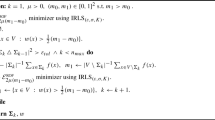Abstract
A generic model-based segmentation algorithm is presented. Based on a set of training data, consisting of images with corresponding object segmentations, a local appearance and local shape model is build. The object is described by a set of landmarks. For each landmark a local appearance model is build. This model describes the local intensity values in the image around each landmark. The local shape model is constructed by considering the landmarks to be vertices in an undirected graph. The edges represent the relations between neighboring landmarks. By implying the markovianity property on the graph, every landmark is only directly dependent upon its neighboring landmarks, leading to a local shape model. The objective function to be minimized is obtained from a maximum a-posteriori approach. To minimize this objective function, the problem is discretized by considering a finite set of possible candidates for each landmark. In this way the segmentation problem is turned into a labeling problem. Mean field annealing is used to optimize this labeling problem. The algorithm is validated for the segmentation of teeth from cone beam computed tomography images and for automated cephalometric analysis.
Preview
Unable to display preview. Download preview PDF.
Similar content being viewed by others
References
Kass, M., Witkin, A., Terzopoulos, D.: Snakes: Active Contour Models. International Journal of Computer Vision 1(4), 231–331 (1987)
Caselles, V., Kimmel, R., Sapiro, G.: Geodesic Active Contours. International Journal of Computer Vision 22(1), 66–79 (1997)
Mumford, D., Shah, J.: Optimal approximation by piecewise smooth functions and associated variational problems. Communications of Pure and Applied Mathematics 42, 577–685 (1989)
Chan, T.F., Vese, L.A.: Active Contours Without Edges. IEEE Transactions on Image Processing 10(2), 266–277 (2001)
Cremers, D., Rousson, M., Deriche, R.: A Review of Statistical Approaches to Level Set Segmentation: Integrating Color, Texture, Motion and Shape. International Journal of Computer Vision 72(2), 195–215 (2007)
Cremers, D.: Statistical Shape Knowledge in Variational Image Segmentation. Universität Mannheim (2002)
Boykov, Y., Veksler, O., Zabih, R.: Fast Approximate Energy Minimization via Graph Cuts. IEEE Transactions on Pattern Analysis and Machine Intelligence 23(11), 1222–1239 (2001)
Boykov, Y., Funka-Leah, G.: Graph Cuts and Efficient N-D Image Segmentation. International Journal of Computer Vision 70(2), 109–131 (2006)
Cootes, T.F., Taylor, C.J., Cooper, D.H., Graham, J.: Active Shape Models - Their Training and Application. Computer Vision and Image Understanding 61(1), 38–59 (1995)
Cootes, T.F., Edwards, G.E., Taylor, C.J.: Active Appearance Models. IEEE Transactions on Pattern Analysis and Machine Intelligence 23(6), 681–685 (2001)
Cremers, D., Osher, S.J., Soatto, S.: Kernel Density Estimation and Intrinsic Alignment for Shape Priors in Level Set Segmentation. International Journal of Computer Vision 69(3), 335–351 (2006)
Seghers, D.: Local graph-based probabilistic representation of object shape and appearance for model-based medical image segmentation. Katholieke Universiteit Leuven (2008)
Seghers, D., Hermans, J., Loeckx, D., Maes, F., Vandermeulen, D., Suetens, P.: Model-Based Segmentation Using Graph Representations. In: Metaxas, D., Axel, L., Fichtinger, G., Székely, G. (eds.) MICCAI 2008, Part I. LNCS, vol. 5241, pp. 393–400. Springer, Heidelberg (2008)
Swennen, G.R.J., Schutyser, F., Hausamen, J.-E.: Three-Dimensional Cephalometry, A Color Atlas and Manual. Springer, Heidelberg (2006)
Ilonen, J.: Supervised Local Image Feature Detection. Lappeenranta University of Technology (2007)
Lampinen, J., Oja, E.: Distortion tolerant pattern recognition based on self-organizing feature extraction. IEEE Transactions on Neural Networks 6, 539–547 (1995)
Kämäräinen, J.-K.: Feature extraction using Gabor filters. Lappeenranta University of Technology (2003)
Koenderink, J.J., Van Doorn, A.J.: The Structure of Locally Orderless Images. International Journal of Computer Vision 31, 159–168 (1999)
Li, S.Z.: Markov Random Field Modeling in Computer Vision. Springer, Heidelberg (1995)
Courant, R., Hilbert, D.: Methods of Mathematical Physics. Interscience Publishers, Inc., New York (1953)
Schölkopf, B., Smola, A., Müller, K.R.: Nonlinear component analysis as a kernel eigenvalue problem. Neural Computation 10, 1299–1319 (1998)
Maes, F., Collignon, A., Vandermeulen, D., Marchal, G., Suetens, P.: Multimodality image registration by maximization of mutual information. IEEE transactions on medical imaging 16(2), 187–198 (1997)
Komodakis, N., Paragios, N., Tziritas, G.: MRF Optimization via Dual Decomposition: Message-Passing Revisited. In: ICCV 2007. IEEE 11th International Conference on Computer Vision, pp. 1–8 (October 2007)
Felzenszwalb, P.F., Huttenlocher, D.P.: Efficient Belief Propagation for Early Vision. International Journal of Computer Vision 70(1) (October 2006)
Wainwright, M.J., Jaakkola, T.S., Willsky, A.S.: MAP Estimation Via Agreement on Trees: Message-Passing and Linear Programming. IEEE Transactions on Information Theory 51(11), 3697–3717 (2006)
Kolmogorov, V.: Convergent Tree-reweighted Message Passing for Energy Minimization. IEEE Transactions on Pattern Analysis and Machine Intelligence 28(10), 1568–1583 (2006)
Kolmogorov, V., Zabih, R.: What Energy Functions Can Be Minimized via Graph Cuts? IEEE Transactions on Pattern Analysis and Machine Intelligence 26(2), 147–159 (2001)
Lowe, D.G.: Distinctive image features from scale-invariant keypoints. International Journal of Computer Vision 60, 91–110 (2004)
Vapnik, V.N.: Statistical Learning Theory. Wiley, New York (1998)
Wiskott, L., Fellous, J.-M., Krüger, N., von der Malsburg, C.: Face Recognition by Elastic Bunch Graph Matching. Intelligent Biometric Tecniques in Fingerprint and Face Recognition. Chapt. 11, 355–396 (1999)
Author information
Authors and Affiliations
Editor information
Editors and Affiliations
Rights and permissions
Copyright information
© 2009 Springer-Verlag Berlin Heidelberg
About this paper
Cite this paper
Keustermans, J., Seghers, D., Mollemans, W., Vandermeulen, D., Suetens, P. (2009). Image Segmentation Using Graph Representations and Local Appearance and Shape Models. In: Torsello, A., Escolano, F., Brun, L. (eds) Graph-Based Representations in Pattern Recognition. GbRPR 2009. Lecture Notes in Computer Science, vol 5534. Springer, Berlin, Heidelberg. https://doi.org/10.1007/978-3-642-02124-4_36
Download citation
DOI: https://doi.org/10.1007/978-3-642-02124-4_36
Publisher Name: Springer, Berlin, Heidelberg
Print ISBN: 978-3-642-02123-7
Online ISBN: 978-3-642-02124-4
eBook Packages: Computer ScienceComputer Science (R0)




